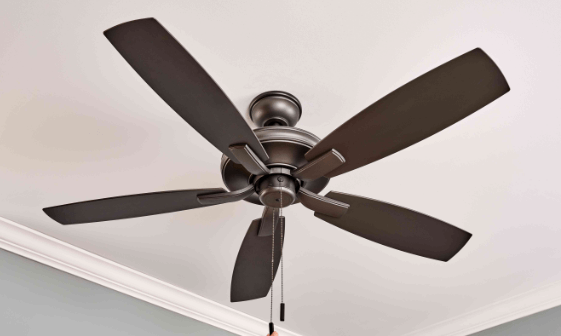Beat the Heat: Should Fans Rotate Clockwise or Counterclockwise in Summer?

Welcome, fellow heat warriors, to the ultimate battle against sweltering temperatures! As summer heats up and mercilessly turns our living spaces into ovens, seeking solace from the relentless heat becomes our top priority. But fear not! We are about to uncover a secret that has puzzled us for ages: should our fans rotate clockwise or counterclockwise during this scorching season? Prepare to be blown away as we dive deep into this hot topic and unravel the truth behind beating the heat with an exhilarating fan-direction debate!
What is the difference between a clockwise and counterclockwise summer fan rotation?
The direction of a ceiling fan’s rotation can significantly impact a room’s comfort and energy efficiency during different seasons. In summer, the difference between clockwise and counterclockwise fan rotation is crucial.
Counterclockwise rotation (summer mode): In the summer, you should set your ceiling fan to rotate in a counterclockwise direction. The blades will move counterclockwise when looking up at the fan from below. This creates a downdraft, which produces a wind-chill effect on the skin. As the moving air passes over your body, it helps to evaporate sweat, making you feel cooler without lowering the room’s temperature. This cooling effect can make a room feel up to 4 degrees Fahrenheit (2.2 degrees Celsius) cooler, allowing you to reduce your reliance on air conditioning and save energy.
Clockwise rotation (winter mode): During colder months, you can reverse the modern ceiling fans with lights direction to clockwise. The blades will now move clockwise when looking up at the fan from below. This causes an updraft, which helps distribute warm air that naturally rises to the ceiling back toward the living space. This recirculation of warm air can help improve heating efficiency and keep the room warmer, reducing the need for heating appliances.
Setting the fan to rotate counterclockwise in the summer helps create a cooling breeze while switching to a clockwise rotation in the winter aids in distributing warm air. Understanding and utilizing these fan rotation settings can enhance comfort and energy efficiency throughout the year.
When should fans be rotated in a clockwise direction?
Fans should be rotated clockwise during colder months or in the winter. This clockwise rotation creates an updraft, pulling the cooler air upwards and pushing the warmer air near the ceiling downwards. By redistributing the warm air throughout the room, the fan helps to maintain a more even temperature and improve heating efficiency. This can be particularly beneficial in rooms with high ceilings where warm air accumulates at the top. Utilizing the fan in a clockwise direction during the colder seasons can help reduce reliance on heating appliances and keep the living space more comfortable.
When should fans be rotated in a counterclockwise direction?
Fans should be rotated counterclockwise during warmer months or in the summer. This counterclockwise rotation creates a downdraft, causing air to move vertically downward. As the moving air passes over the skin, it creates a wind-chill effect, making you feel cooler without lowering the room’s temperature. This can help improve comfort during hot weather and reduce reliance on air conditioning, saving energy. Setting the fan to rotate counterclockwise during summer maximizes its cooling potential and creates a pleasant and refreshing breeze throughout the room.
What are the benefits of fan rotation?
The benefits of fan rotation depend on the direction the fan is set to spin, either clockwise or counterclockwise, and the season in which it is used.
Clockwise rotation (winter mode):
Improved Heating Efficiency: During colder months, rotating the fan clockwise helps redistribute warm air that naturally rises to the ceiling. This updraft pushes the warm air back towards the living space, improving heating efficiency and keeping the room warmer without relying solely on heating appliances.
Energy Savings: Using the fan to circulate warm air can reduce the need for heating, leading to energy savings and lower utility bills.
Comfortable Environment: Properly circulating warm air helps maintain a more comfortable and cozier indoor environment during winter.
Counterclockwise rotation (summer mode):
Enhanced Cooling Effect: In hot weather, rotating the fan counterclockwise creates a downdraft, producing a cooling breeze that makes occupants feel up to 4 degrees Fahrenheit (2.2 degrees Celsius) cooler through the wind-chill effect. This refreshing breeze helps combat discomfort in warmer temperatures.
Energy Efficiency: Using the fan to supplement air conditioning, you can raise the thermostat setting without sacrificing comfort, resulting in energy savings and reduced cooling costs.
Improved Air Circulation: Counterclockwise rotation promotes better air circulation in the room, preventing stagnant air and minimizing hot spots.
Overall, leveraging fan rotation effectively throughout the year contributes to energy efficiency, cost savings, and improved comfort in the home, making it a valuable asset in maintaining a pleasant indoor environment regardless of the season.
Conclusion
It’s summertime, which means it’s hot outside. Whether you’re sweating bullets under the sun or struggling to keep cool in a hot climate, you may wonder whether fans should rotate counterclockwise or clockwise in summer. After all, what feels right for one person might not be the best choice for another. The answer is that it depends on your body and how strong the heat sensations are. While some people may feel more comfortable rotating their fans counterclockwise, others prefer to do so clockwise for a more calming effect. Ultimately, it’s important to experiment a little and find out what works best for you!




